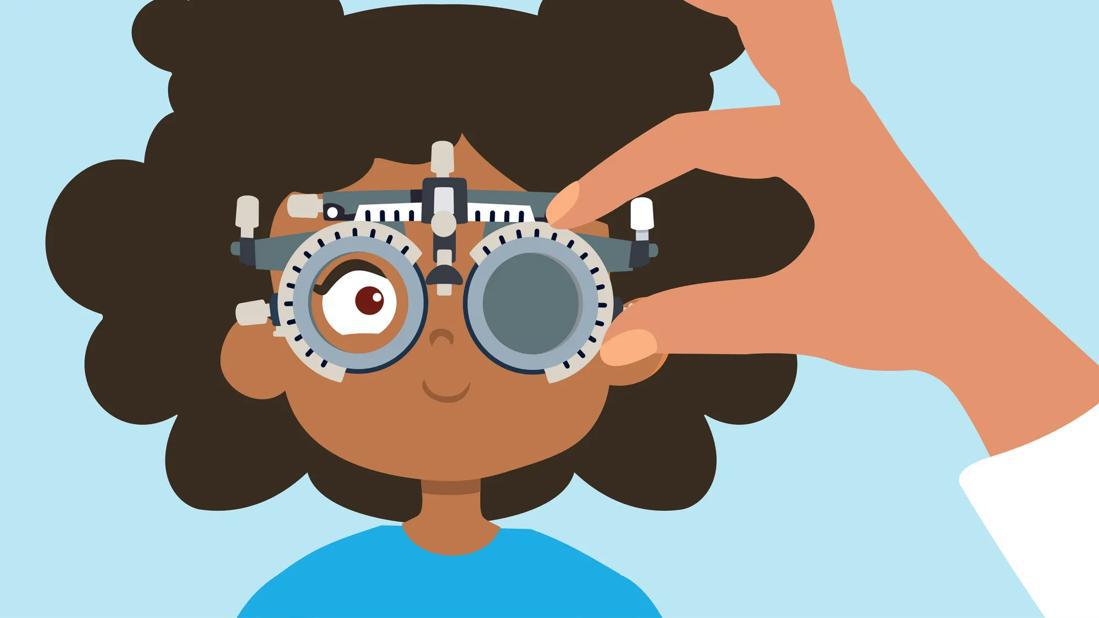Your Child Should Have a Pediatric Eye Exam Early and Often
Have their eyes evaluated shortly after birth, before their first birthday, and at ages 3, 5 and beyond

When should you get your child’s eyes checked? Pediatric ophthalmologist Elias Traboulsi, MD, MEd, says the answer is simple: early and often.
Some eye problems start in infancy and can affect vision for life. Catching issues early on can stop small ones from becoming bigger (and harder to treat) later on.
When should children get a pediatric eye exam?
Following the American Academy of Ophthalmology, and from his personal experience, Dr. Traboulsi recommends pediatric eye exams at:
- Birth, usually by a pediatrician or neonatologist
- 6 to 12 months by an ophthalmologist
- 1 to 3 years (as needed)
- 3 to 5 years at school entry
- Every two to three years after age 5
These exams are even more important for kids who:
- Have a parent or sibling with an eye disease or a condition like lazy eye (amblyopia)
- Have a vision problem found by their pediatrician or during vision screening at school
If any of these apply — or if you think your child might have a vision problem — talk to your pediatrician or schedule an eye exam.
“Even if there are no obvious symptoms, your child may still have a problem with their vision,” says Dr. Traboulsi. “There’s no harm in getting a comprehensive eye exam.”
What to expect
A pediatric eye exam begins with an open discussion about your child’s health, vision concerns and any family history of eye conditions. Based on these factors, a pediatrician or eye doctor will use different tests to evaluate your child’s eye health at different ages.
- For newborns, doctors check how their eyes line up and respond to light and touch.
- Between 6 and 12 months, your child gets the same eye tests again. The doctor also checks how their eyes and eye muscles move. If access to an ophthalmologist is available, this examination is better performed by them.
- From 1 to 3 years, providers track your child’s eye development. They may refer you to an eye specialist for issues like lazy eye or crossed eyes (strabismus).
- Between the ages of 3 and 5, they check how well your child can see. If needed, your child may also receive a color blindness test or a photo screening of the back of their eye.
- After age 5, healthcare providers keep checking your child’s vision. If needed, they can correct any refractive errors, like nearsightedness or astigmatism, with eyeglasses and other treatments.
“Right now, we don’t think every child needs a full eye exam unless there’s a concern,” clarifies Dr. Traboulsi. “Having said that, if it’s possible, there’s no harm in getting a really comprehensive eye exam.”
What if your child is nonverbal or has difficulty reading?
If your child is nonverbal or has difficulty reading, they can use what’s called a preferential looking test or Teller Acuity Card® test. During these exams, a provider holds up cards that have a pattern or image on one side and nothing on the other. They observe which part of the card your child looks at and how they interact with that image.
“We then hold up cards with tighter and tighter patterns to determine how well your child can see them, until a point where they randomly look at the other side so that we know they’re not seeing it anymore,” explains Dr. Traboulsi. “That grating will give us an idea of the limit to their vision.”
Older children ages 3 to 6 who have difficulty reading or identifying their letters can also be tested by matching images and numbers on cards instead of reading a traditional eye chart.
School vision test vs. comprehensive eye exams for kids
Pediatric vision screenings and eye exams have similar goals, but one is more involved than the other.
Most kids have a pediatric vision screening before they start elementary school, especially if parents notice behaviors that signal they may have issues with their vision. These eye tests for preschoolers can be handled by your child’s school officials, nurses or pediatricians who are looking for visible signs of vision problems. Like regular physical exams, screenings are the first step of preventive care for your child’s eyes. They give healthcare providers a general sense of your child’s overall ability to see clearly.
Pediatricians and eye specialists usually recommend comprehensive pediatric eye exams as a follow-up to any red flags that are raised about your child’s vision. These tests are more in-depth and cover a wider range of testing to measure the actual health of your child’s eyes.
“If you’re suspicious that something is wrong, you shouldn’t take any chances,” advises Dr. Traboulsi. “You should come in for a complete, comprehensive eye exam where we can put all of these things into perspective.”